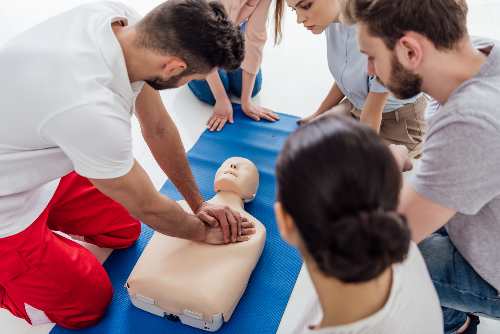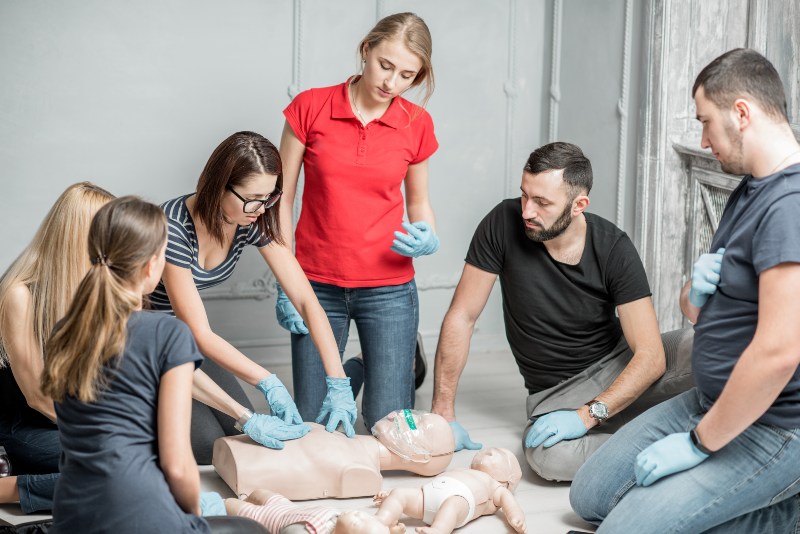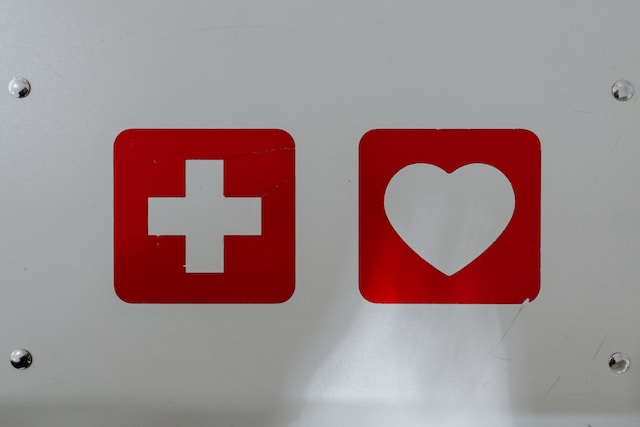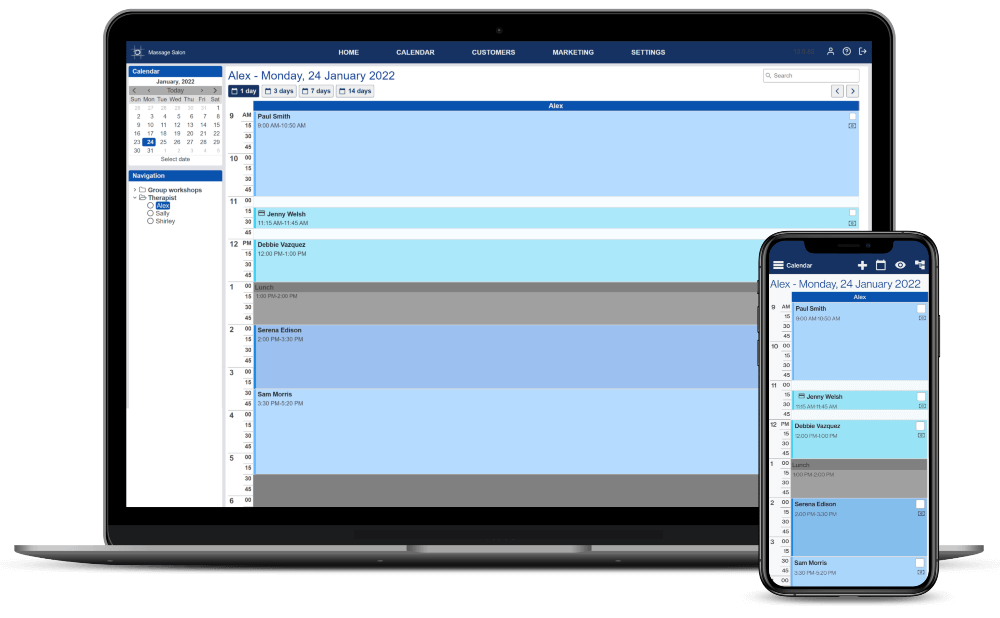
How to Start a CPR and First Aid Business: Everything You Need to Know
In recent years, there has been a growing demand for CPR and first aid training.
Thus, starting a CPR and first aid business in 2023 can be a fulfilling and rewarding venture.
Not only is there a huge opportunity to make profits in this booming industry, but as an entrepreneur, you’ll also have the chance to provide a difference in saving lives and providing the well-being of those in your community.
The potential market for CPR and first aid training is both diverse and large due to a number of factors:
- Increasing awareness of the importance of first aid all over the globe
- There’s an increasing number of people requiring CPR for their jobs
- The growing number of public access AEDs (Automated External Defibrillators)
- The growing interest in CPR and first aid training in schools and organizations
And others.

By the end of this guide, you will have a solid foundation on how to launch your CPR and first aid business. Without further ado, let’s dive into this article right away.
CPR and First Aid Business: an Overview
At its core, the CPR and first aid business provide training to individuals or businesses on how to perform first aid and CPR:
- First aid is the immediate care given to an individual who is ill or injured to provide relief or comfort until they can gain medical help and prevent the condition from worsening.
- CPR stands for cardiopulmonary resuscitation, and it is a form of first aid technique used to restart an individual’s heart that has stopped beating.
The CPR and first aid business may offer a variety of training programs, including but not limited to:
- In-person classes: this is the most common and traditional form of training. In this type of CPR/first aid business, the classes are typically held in a physical classroom, taught by a certified instructor.
- Online classes: a convenient option for those who can’t attend in-person classes, online CPR and first aid courses typically include video lessons, practice exercises, and quizzes.
- Hybrid learning: this type of learning combines online and in-person components, offering more versatility for those who want the flexibility of online courses but also want the physical interaction of in-person classes.
How a CPR/First Aid Business Charges Its Clients
A CPR and first aid business may charge its clients in a number of different ways, but the most common ones are:
- Charging by the hour: the most common method of charging for CPR and first aid training business. The business can set a set hourly rate for the training services.
- Charging per person: this method of charging is based on the number of participants who attend the class. The first aid/CPR business can charge a set rate per person.
- Package pricing: this pricing model involves offering a package of training services at a discounted rate. For instance, the business may offer a package that includes first aid, CPR, and AED training. The business may also offer group discounts, for example, offering a discount to organizations that send multiple employees to the training program.

Ultimately, there is no one-size-fits-all way to charge your clients, and it will depend on your target audience and other factors. In most cases, however, you can’t go wrong with charging an hourly rate as you are just starting out, and you can experiment with offering package pricing/discounts as your business grows.
Starting a CPR and First Aid Business: Securing Legal and Regulatory Compliance
Certification Requirements for a CPR and First Aid Business
Do you need to get certified before you can start a CPR and first aid business?
The legal requirement for starting a first aid/CPR training business can vary depending on the country, region, or state in which you plan to operate.
It’s best to consult with local authorities and/or legal professionals to determine the specific requirements for starting a CPR and first aid business in your location. However, certification is typically a legal requirement.

With that being said, even if you are not legally required to get certified, there are a number of reasons why you should consider getting a certification:
- Credibility: being certified shows your potential clients that you have the skills, experience, and knowledge required to teach first aid and CPR. This can add credibility to your business and help you find clients.
- Staying informed: getting certified by a relevant organization(s) like the Red Cross means you gain access to the organization’s network of information. This can help you stay up-to-date on the latest trends and CPR/first aid techniques, which is important with the constantly evolving nature of the first aid techniques.
- Protect your business: last but not least, being certified can help protect yourself and your business from liability. If your client is injured while you are teaching them first aid or CPR, you may be sued. In this scenario, having a certification can help you show that you acted in a reasonable manner and that you were qualified to provide training.
Organizations Offering First Aid and CPR Certifications
A number of organizations offer CPR and first aid certifications, and there may be different types of certifications offered.
Some of the most popular options are:
- American Red Cross (ARC). The American Red Cross is one of the most well-known organizations offering first and CPR certifications. ARC offers certifications for both individuals and organizations, including Basic Life Support (BLS) certification, CPR/AED certifications, and various first aid courses.
- American Heart Association (AHA). The American Heart Association is another well-known organization offering CPR and first aid certification programs. They offer BLS certification, Heartsaver CPR/AED certification, and Heartsaver First Aid certification, among other programs.
- National Safety Council (NSC). NSC is a non-profit organization offering a variety of safety, first aid, and CPR courses. The National Safety Council offers a number of courses similar to the American Heart Organization and the American Red Cross.
Registering The Business and Obtaining Licenses
While the process and requirements for registration and licensing may vary depending on your local jurisdiction, here are some general steps to consider to register your business and get the necessary licenses:
- Business registration: register your business with the appropriate authority or government agency. You will need to choose a business structure (sole proprietorship, LLC, corporation, etc., and fill in the necessary paperwork.

- Getting the required licenses and permits: do your research and check with your local chamber of commerce or business registration office for the specific licenses or permits required for operating a CPR and first aid business in your area. You may also contact business licensing agencies to get help with the application process. There may be fees associated with business registration and getting the required licenses, which may vary depending on your location and other factors.
- Tax obligations: register for applicable taxes (business tax, sales tax, etc.) Consult with your local tax authorities or a tax professional to ensure compliance with tax regulations in your area.
Understanding Insurance Requirements
Depending on your location, liability insurance may or may not be a legal requirement before you can start the first aid and CPR business. However, even if it’s not a legal requirement, getting liability insurance is crucial to protect your business against potential damages or legal claims that may arise during your training sessions or other business-related activities.

Consider getting at least the following:
- General liability insurance: this type of liability insurance protects your business from claims related to property damage and injuries that may occur at your premises and/or during training sessions.
- Professional liability insurance: also known as “errors and omissions insurance,” this type of insurance protects your business from financial losses that may result from professional negligence, inadequate instruction, or other mistakes/errors made in the course of providing your training services. Professional liability insurance could help to cover medical expenses and/or legal fees.
- Workers’ compensation insurance: if you have employees, this type of insurance is legally required in most states and protects your employees from financial losses (i.e., lost wages, medical expenses) that may result from work-related illnesses or injuries.
- Property insurance: as the name suggests, this type of insurance protects your first aid and CPR business’s property. For example, if your training facility is damaged by a fire incident, then this insurance could help to cover the repair costs.
We’d recommend consulting with insurance professionals specializing in liability insurance for small businesses to determine the best possible option for your business.
Staying Compliant with Health and Safety Regulations
As a first aid and CPR business, naturally, it’s critical to prioritize health and safety standards and ensure the business complies with health and safety regulations.
Consider:
- Training facility safety. Make sure that your training facility meets adequate safety standards, including but not limited to:
- Proper ventilation
- Adequate space
- Appropriate training equipment
- Good implementation of safety protocols (i.e., emergency response plans, first aid kits, etc.)
- Instructor qualification: make sure that your instructors possess the required certifications, experience, and qualifications to deliver first and CPR training. Monitor and stay up to date with industry standards, trends, and guidelines to ensure your training programs align with the latest best practices.

- Participant safety: it’s critical to prioritize the safety of participants during classes. Establish clear safety protocols, provide clear instructions/demonstrations, and always supervise practice opportunities to minimize the risk of accidents.
- Documentation and Recordkeeping: maintain comprehensive and accurate documentation of certifications, participant information, and training sessions. This helps your business ensure compliance and facilitates efficient recordkeeping for future reference purposes.
Starting an In-Person First Aid/CPR Business: Choosing The Ideal Location
For first aid and CPR businesses that are planning to provide in-person/physical classes, one of the most critical factors for success is the location.
When selecting a suitable location for your business, here are the most important considerations:
- Compliance with regulations: make sure that the chosen location and/or facility comply with local building codes, health/safety requirements, and zoning regulations. Check whether there is adequate lighting, ventilation, and restroom facilities, among other required details.
- Space requirements: pretty self-explanatory; make sure the facility has enough space based on the number of participants you plan to have in each training session. Consider space for training equipment, CPR mannequins, and comfortable enough seating arrangements.
- Accessibility: choose a location that is accessible to most of your target audience. Location near residential areas, schools, healthcare facilities, or workplaces is typically ideal. Make sure there is enough parking space and/or accessibility to good public transportation.
Starting an Online/Hybrid First Aid/CPR Business: Establishing Your Virtual Classroom
On the other hand, if you are planning to start virtual or hybrid first aid/CPR training programs, the most important consideration is to establish a good virtual classroom for your participants.

Consider:
- Choosing the right virtual learning platform: there are a number of virtual learning platforms or learning management systems available in the market with varying price ranges and features offered. Make sure to choose a user-friendly platform that allows participants to easily access course materials, complete modules/assignments, and interact with instructors/other participants through forums or video conferencing.
- Develop engaging content: for virtual classes, content is king. It’s critical to develop engaging content like videos, interactive modules, virtual simulations, quizzes, and others to ensure optimal engagement and effective learning.
- Practical sessions: facilitate practical sessions where participants can apply their newly learned first aid/CPR skills. Provide clear and concise instructions, and use visuals to illustrate the skills. Also, consider organizing in-person practical sessions at a suitable location so participants can practice under the guidance of qualified instructors.
Hiring and Training Qualified Instructors
Another critical factor in running a successful CPR and first aid business is the availability of qualified instructors.

It’s very important to hire instructors who possess the necessary skills, experience, and qualifications, and you might want to consider the following:
- Credentials/certifications: it’s recommended to look for instructors who hold recognized certifications in first aid and CPR, such as from American Red Cross (ARC) or American Heart Association (AHA.)
- Experience and expertise: look for candidates with practical experience in providing first aid and CPR training, like those who have worked in emergency medical services or other healthcare-related fields. Real-life experience will be very valuable to your training sessions.
- Teaching skills: not everyone with experience in first aid or CPR has the ability to effectively communicate, teach, and engage with participants. Look for those who can explain complex concepts clearly and concisely. Patience and the ability to create an engaging and supportive learning environment are also important qualities to look for.
Providing Training and Professional Development
Your job doesn’t end once you have identified and hired the right instructors for your business, but you’ll need to provide ongoing training and professional development opportunities for your instructors.
Doing so ensures your instructors stay up-to-date with the latest trends and first aid/CPR techniques so they can maintain their teaching qualities.
Consider:
- Onboarding training: provide instructors with a comprehensive initial training and orientation program. This initial training program should cover your specific training methodologies, curriculum, instructional, administrative policies, and resources relevant to your CPR and first aid business.
- Continuing education: encourage instructors to pursue continuing education or training opportunities (i.e., seminars, workshops, conferences, classes, etc.) so they can continuously enhance their knowledge and skills. Provide financial support if necessary.

- Skill updates: regularly update your instructors on new trends and changes in first aid/CPR guidelines, best practices, and safety protocols. Provide them with access to reliable resources to ensure their knowledge remains up to date.
- Feedback and evaluation system: establish a clear and concise feedback mechanism so you can effectively assess the performance of your instructors. Collect feedback from participants and conduct regular evaluations so you can, in turn, provide constructive feedback for your instructors.
Developing Course Curriculum and Content
At the core of your first aid and CPR business are your training materials, so it’s important to develop a comprehensive curriculum and ensure the high-quality content of your training program.
Consider:
- The target audience: who are your training programs targeted at? The curriculum and training materials should be appropriate for the skills, knowledge, and experience level of your specific target audience.

- Learning objectives: for example, healthcare professionals may require more advanced CPR and first aid techniques. On the other hand, if your training programs are designed for parents, you can focus on including more child-specific first-aid techniques.
- Accredited programs: it’s possible to adopt training materials that are already accredited by recognized organizations (i.e., American Red Cross or American Heart Association.) This may add to your initial costs but will provide you with more convenience and credibility.
- Manuals and guides: create comprehensive and well-structured training guides and manuals for your participants. This can be in printed or digital form, but it should include clear instructions and explanations. Consider incorporating illustrations and visual aids, such as diagrams, charts, or even videos (for digital guides.) Doing so may facilitate more effective learning and help participants retain the information better.
- Different levels of certification: depending on your target audience, you may want to offer courses at different levels. For example, you can offer a basic CPR and first aid course, pediatric CPR class, and advanced first aid class with varying curriculums and prices. This enables potential participants to choose the appropriate class based on their specific needs.
- Practical demonstrations: include live demonstrations of first aid techniques and CPR to facilitate participants with a clear understanding of these techniques. If possible, make this live demonstration in person by experienced instructors, or alternatively, you can use videos.
- Practice sessions: allocate time for participants to practice first aid and CPR skills under the supervision (and guidance) of instructors. Even for online classes, consider arranging an in-person practice session, for example, in a rented facility.
- Scenario-based and role-playing training: conduct scenario-based training exercises where participants can apply their learned skills in simulated emergency situations. Encourage role-playing activities and group discussions to facilitate collaborative learning and encourage active participation.
By creating a comprehensive curriculum with appropriate training resources and materials, you can deliver engaging CPR and first aid training and attract more participants.
Creating a Strong Online Presence
Having a strong online presence is essential for any business in today’s digital landscape.
If people can’t find your first aid and CPR business online, in their eyes, you don’t exist, period. This is why having an optimal online presence is critical to help your business reach a wider audience and get more appointments.

Here are some tips for creating a strong online presence for your first aid and CPR business:
- Build a professional website: your website should be well-designed, fully functional (bug-free,) easy to navigate, and includes all the important information related to your business. Fortunately, with platforms like WordPress, Wix, Squarespace, or others, creating a professional website is now much more accessible and affordable.
- Build a strong social media presence: regularly publish high-quality content and build followers on social media platforms your target audience is active in (i.e., Instagram, Facebook, Twitter, LinkedIn, etc.) Respond to their questions and inquiries, post regularly, and consider investing in paid advertising options as well as influencer marketing.
- Leverage online directories and review sites: claim listing on Google Business (Google Maps) and other relevant online directories to build credibility and attract new customers. Encourage (incentivize) existing customers to leave reviews for your business on these platforms.
Implementing a Booking and Appointment System
As a service business, your first aid and CPR training business would rely on client appointments, so it’s critical to implement a streamlined and functional booking/appointment system to ensure:
- It’s as easy as possible for potential participants to book your class anywhere, anytime, and from any device
- It’s easy for you to manage your appointments and scheduling to avoid double bookings and no-shows
Bookeo is a popular online booking and appointment scheduling solution that allows you to easily integrate a booking system into your website (or create a booking website from scratch), manage your appointments, and send automated reminders to participants.

Bookeo offers a variety of unique features that can be beneficial for CPR and first aid businesses, such as:
- 24/7 online booking:with Bookeo’s training and course scheduling software, participants or clients can easily book their CPR and first aid training sessions online.
- Secure payment processing: Bookeo supports a number of popular payment options, including credit/debit cards, PayPal, and Stripe, among others.
- Automated reminders: Bookeo sends automated SMS or email reminders to your class participants. This can effectively reduce the likelihood of no-shows and improve your classes’ attendance rate.
- Flexible scheduling: easily customize your training schedule with different session lengths. You can also set up recurring classes schedule with ease.
Following the tips above would help you create a strong online presence for your first aid/CPR business, secure more clients, and grow your business.
Wrapping Up
Starting a CPR and first aid business can be a lucrative and rewarding venture that allows you not only to make profits but also to make a significant impact on the community. You can help people learn new life-saving skills and knowledge while building a successful business in the process.
By following the steps we’ve discussed in this guide, you can get started on the right foot and increase your chances of success.
If you need an efficient, user-friendly, and effective online booking system, Bookeo can be a great option. Its features and benefits can streamline your online booking and appointment management so you can attract more clients and grow your first aid and CPR business.

